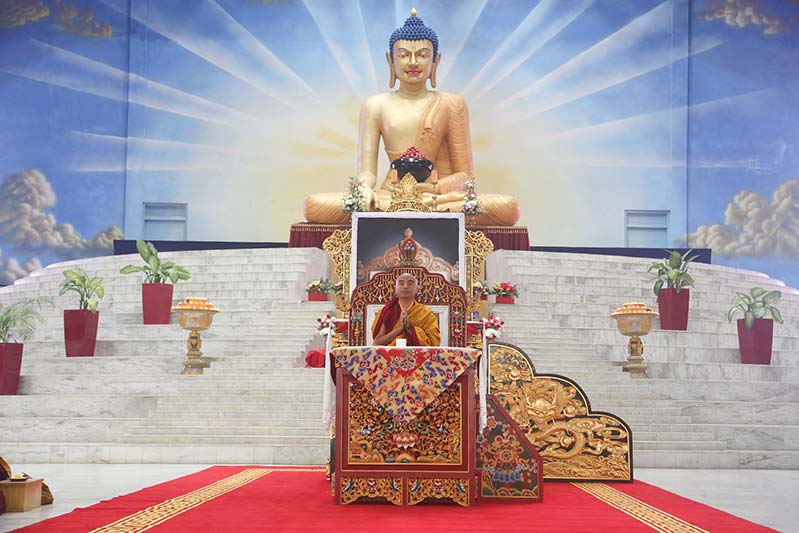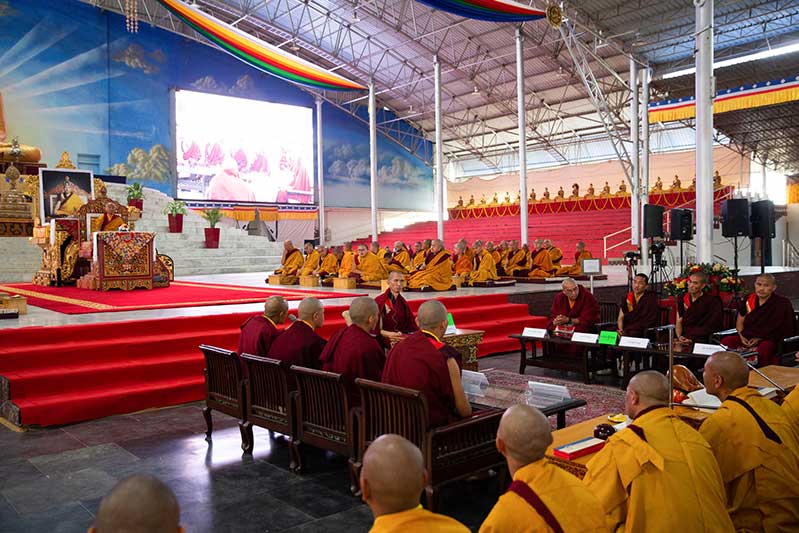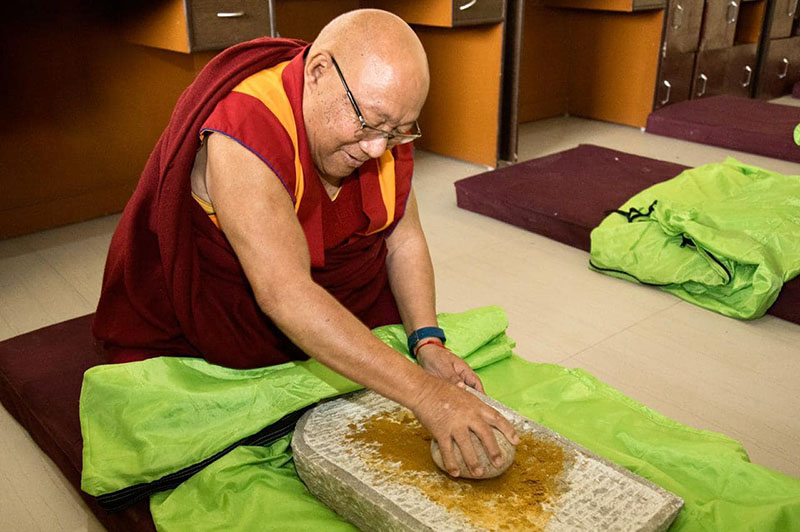
The Pavilion, Bodh Gaya, India
January 28, 2020
Before the Kagyu Monlam begins, it has been traditional to have several days of teachings, and this year Yongey Mingyur Rinpoche is giving instruction on the practice of the Four Foundations of Mindfulness (being mindful of the body, feelings, mind, and phenomena). This opening session began with the Mahamudra Lineage Prayer, taking refuge, generating bodhichitta, and an extensive mandala offering for this initial day. All of these texts were projected in Tibetan, English, and Chinese on two screens that flanked the spacious stage where Mingyur Rinpoche sat on a beautifully carved throne.
Why We Practice the Four Foundations
Rinpoche began by explaining the reason why we practice the Four Foundations of Mindfulness: The essence of the 84,000 teachings of the Buddha is to tame our minds so they become peaceful, and this allows us to discover liberation within our own minds. We find the same message in the famous verse:
Do not do anything wrong,
Practice perfect virtue,
And completely tame your mind—
These are the Buddha’s teachings
To school our minds well, we have to practice calm abiding (shamatha), insight meditation (vipashyana), and the five paths—accumulation, joining, seeing, learning, and no more learning. For all these practices, the Four Foundations of Mindfulness are key, as they allow us to subdue our minds and naturally achieve liberation. Mingyur Rinpoche commented, “We discover that liberation is found nowhere else but within our own mind.”
When that happens, we become happy and peaceful. If not, we are uncomfortable and disturbed. We could be practicing while our mind is circumambulating the world. We are thinking, “When will this session end?” And when it is finished, we leave just like mice escaping a trap. When the time comes to begin once more, we sigh, “Oh, I have to practice again.”
So it is difficult and we suffer, experiencing hatred, envy, pride, desire, and ignorance. This makes for a life full of pain, troubled by fear and disappointment. We put ourselves down, thinking, “I can’t do it.” “People don’t like me.” “I know something about this,” Rinpoche elaborated, “since when I was young, I had panic attacks that drained my energy.”
To pacify all these sufferings, we practice listening, reflecting, and meditating. If we skip over meditation, our practice will resemble someone trying to climb a cliff without arms. If we can really practice, wherever we are is pleasant.
In brief, these are the reasons for engaging in the Four Foundations of Mindfulness. And if we persevere, they will lead us through the five paths to full realization. The Four Foundations are taught in the sutras and embody all of the Dharma: there is no teaching that is not included within them.
The Preparation: Going for Refuge
The preparation for this practice involves taking refuge and generating bodhichitta; the main practice is calm abiding, and the completion or follow through, is dedication. Actually, these three aspects—the preparation, main practice, and completion—are found in all Dharma practices. In the case of insight meditation, the main practice shifts to emptiness or being without reference point, free of the three spheres of subject, object, and action.
Mingyur Rinpoche then turned to practice itself:
During the preparation stage, we visualize in the space in front of us Vajradhara as the essence of all our gurus. All the yidam deities, such as Chakrasamvara or Vajra Yogini, and all the Dharma protectors, such as Mahakala, are also the same in essence. In this way, all the gurus, yidam deities, and protectors are included in our meditation.
Sit up straight and visualize Vajradhara in front of you. If you think clearly that the Buddha is before you, he is there and looking at you, his eyes filled with compassion and love, protecting you wherever you go.
Then the whole assembly recited the refuge prayer:
Until I reach awakening, I go for refuge to the Buddha,
To the Dharma and to the supreme Sangha.
Through the merit of accomplishing the six perfections,
May I achieve awakening for the benefit of all living beings.
Afterward, Mingyur Rinpoche commented:
If it’s difficult to visualize Vajradhara, simply think that he’s in front of you. It is certain that he will think of you and know you because there is no near or far. Go to him for refuge and ask that your mindstream be pacified. Pray that through practicing the five paths, you will receive all the qualities of abandoning (all that is to be abandoned) and realizing (mind’s true nature).
Bodhichitta
After a pause for meditation, Rinpoche spoke about bodhichitta—the mind turned to enlightenment or the mind full of awakening. In bodhichitta we aspire, “Whatever practice I do, I do to bring all living beings to the state of buddhahood. Whatever merit I have is dedicated to assisting all living beings in moving along the five paths into full awakening.”
Following refuge, everyone recited the Four Immeasurables, which embody the essence of bodhichitta:
May all living beings be happy and have the cause of happiness.
May they be free of suffering and its causes.
May they know the highest joy that is free of suffering.
May they dwell in equanimity, free of attachment or aversion to those near or
far.
After a short time for meditation, Rinpoche checked in with his audience: “So how was it? Did you have a thought or feeling of bodhichitta? Did it turn out well? Or was it not that great? Did you tell yourself, ‘I need to meditate on bodhichitta,’ and your mind went blank? Or did you have a jumble of thoughts?”
In general, bodhichitta relates to our motivation, he commented. For example, we need to come to Bodh Gaya but before coming, we first think, “I’m going to Bodh Gaya to participate in the Kagyu Monlam.” That’s our motivation. It is a plan: I‘ll do this in the future, and my reason is to accomplish this or that. We all have plans for the future. For example, “Today I’ll go to the mall, because I have to buy a nice phone, the best one for the lowest price.” If we have that motivation, we will go around looking for the greatest mobile. Rinpoche explained:
Our motivation resembles a plan: we want to develop our bodhichitta, so we need to listen, reflect, and meditate. These days in Bodh Gaya, we are doing the practices and pujas of the Kagyu Monlam, and there could be different motivations for coming here. With sincerity and faith, some might have the good motivation of bodhichitta and think this is a great opportunity. Others might feel that they had no choice; otherwise the discipline master would chew them out!
So in the beginning, it’s important to examine our motivation. We will spend a minute or two looking to see what ours is. What is your reason for meditating and taking Dharma teachings?
After a period of meditation, Rinpoche asked: “What was your motivation? Bodhichitta? Something middling or neutral? Unvirtuous? Was there hatred or pride? Curiosity? Did you think, ‘I’ll take meditation instruction and become peaceful and happy so I can benefit all living beings and bring them to realization and happiness.’? We need to recognize what our current motivation is.”
Rinpoche recalled his personal experience:
When I was seven, I had panic attacks. My heart was thumping in my chest and I had terrible nightmares. At nine, I received meditation instruction from my father, Tulku Urgyen Rinpoche. We can think meditation is good, but when it comes to doing it, we get lazy and our mind is filled with a tangle of thoughts. We need to push through these situations to turn our mind around.
So at thirteen, I entered the three-year retreat. The retreat master, Saljay Rinpoche, said, “You have to look carefully at your motivation for practicing.” Mine was to overcome the panic attacks. If I got over them, that would be enough.
Rinpoche continued, “First we need to recognize our motivation and then we can transform it into bodhichitta, the wish to achieve complete and perfect realization for the sake of all living beings.” Developing bodhichitta has two facets: the first is focusing on all living beings and the second is focusing on complete and perfect buddhahood. Both are needed.
Rinpoche then asked:
“If you had wisdom, love, and a special power to bring all living beings to full awakening right now, would you do it or not?” Within our minds, we all have the basic motivation of bodhichitta—we would bring even our enemies to buddhahood. We can investigate to see if we have this motivation or not, since ultimately, there is nothing in our minds that is hidden from us.
The power to bring all living beings to full awakening comes from practice. Right now we do not have the power to help everyone; caught in suffering and the onrush of thoughts, we cannot even help ourselves. Recognizing this, we decide that in order to achieve the ability to help, we will practice listening, reflecting, and meditating.
This motivation includes bodhicitta as an aspiration and as a practice. It means making the promise to accomplish the ultimate result, for to promise to engage in the cause involves the promise to achieve the result. If we can practice bodhichitta for one minute, our lives have become meaningful. The moment we achieve bodhichitta, we become worthy of respect from the entire world. In brief, to purify misdeeds and gather the accumulation of merit, we must meditate on bodhichitta.
With this, Mingyur Rinpoche concluded his explanation of the preparations for the practice of calm abiding. He then turned to the second part, the main practice of calm abiding or shamatha.
The Main Practice of Calm Abiding
Mingyur Rinpoche mentioned that there are a number of ways to do this practice of calm abiding, and the most well-known is focusing on the breath. The Treasury of the Abhidharma by Vasubhandu gives six different ways of using the breath, by counting it, by following it as it goes in and out, and so forth. Rinpoche noted, “When we focus our mind on the breath, prajna or wisdom arises, and the essence of samadhi (meditative concentration) is prajna.”
He then explained that a cycle of breathing in and out counts as one breath. In this way, we count up to ten since a larger number can allow distraction. Once at ten, we take a short break and begin again, following the breath in and out to the length of a cubit or about eighteen inches.
After a period of practice, Mingyur Rinpoche asked, “How many times did you breathe in an out? More than five? Raise your hand. More than ten? Or fifteen? Twenty?” People have different rates of breathing, he stated, but the main thing is to maintain your focus on the breath. Rinpoche clarified:
If you can count to ten, you have achieved one level. If you can count your breath, you’re in the samadhi of resting your mind on breath. You do not need to worry if you are in samadhi or not. Sometimes you might think of your mom or your phone. Let any thought come, as there is no need to block them. The point is to keep counting breaths, no matter if you have ten, fifteen or twenty thoughts, because if you try to block them, they’ll just increase.
He then led a special meditation that had just one rule: For one minute, we were not allowed to think about mobiles, iPhones, Samsung, or any other brand. If even one thought of a phone came up, our meditation was finished. We could think about tea or the chili noodles sold by the vendors outside the Pavilion, but not one notion of a phone could arise.
After this meditation, Rinpoche asked, “OK, how did it go? Raise your hand if you thought of a phone.” And many people raised their hands. “If you’re not allowed to, of course, you’ll think of a phone,” he said. “Our minds are not workable, because we do not have control over them. The benefit of the practice of samadhi is that our minds become workable.” He continued, “And this reaction is not limited to phones, it also applies, for example to having fear in your mind. When I was young and panicked, I thought ‘I can’t be afraid. I can’t panic,’ and the panic attacks got worse.”
The same is true of taking tests. Beforehand we think that when we take this exam, we will be relaxed but when the time comes, we are even more uptight. It is also true that if we try to block the three poisons (ignorance, excessive desire, and aversion), repressing them will not work either. “We need to apply our awareness, and naturally our minds will become workable,” he said. “If our minds are not stable, we need to work with them.”
Elaborating on the example of a test, Rinpoche recounted that when we have to take a test, we prepare intensively for ten or fifteen days and have our answers all ready. But when we get to the exam hall, our mind is half empty and we cannot remember what we had planned. We try everything, even pray to the Three Jewels, but the answers do not come and we sweat through the three hours. Afterward, we go outside and then up come all the answers. This happens because our minds are not workable. Once they are, whatever we are doing, we can think about what we need to think about. In terms of practice, if our meditation is on love or bodhichitta, we can focus properly and do the meditation. He summarized, “Applying our awareness to understand our mind is the basis here.”
This concluded the first stage of meditation based on the breath. For the break that followed this teaching, Mingyur Rinpoche gave the audience homework: “As you walk around during the half hour, as you drink your tea or go to the toilet, focus on your breath. There is no need to count—being aware of one cycle is enough. Do this many times.” And so the practice continued between sessions.







































